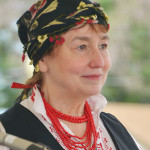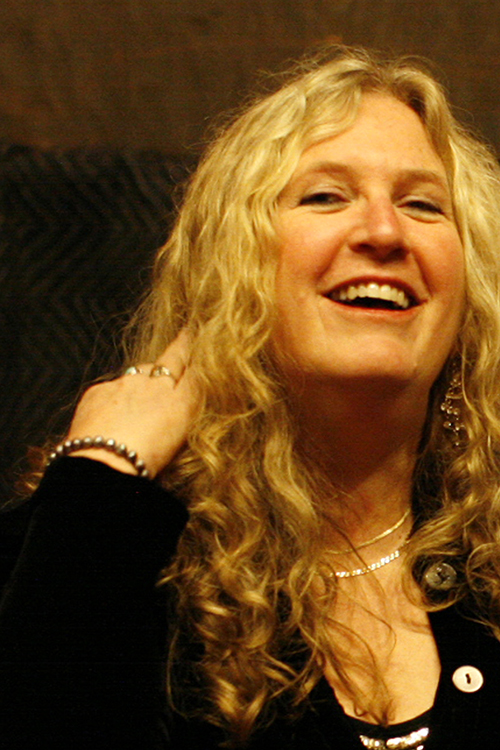
At Balkan camp 2011. (photo: April Renae)
Known for her warm and welcoming teaching style, Lise Liepman has taught santouri (Greek hammered dulcimer) or Greek ensemble off and on at EEFC Balkan Music & Dance Workshops since 1988, mostly at Mendocino and several times at the East Coast Workshops, and taught Turkish dancing at balkanalia! when that camp was produced by EEFC. She’s also a carousel-restoration artist.
When Lise Liepman was in eighth grade, she had to create a family tree for a school project. She wrote the whole family tree, filling in occupations where possible.
“Under my name I put ‘Artist? Musician?’ and ended up being both,” she says. “Who knew?”
Growing up in Southern California and moving to Marin County (Northern Calif.) at age 14, Lise was part of a musical family. Her great-great-grandfather was a double-bass player, her maternal grandfather the first-chair violinist in the Boston Symphony, and her German father’s family claimed classical musicians as far back as the 1800s. All four children studied classical music, Lise on piano. (Lise’s two brothers perform with classical orchestras to this day.)
Her first exposure to Balkan music and dance was a folk dance physical education class at her high school.
“It was probably the Israeli dancing that grabbed me first,” she says. “Probably something like Mayim—it was fun, like running. The dances were kind of organized but also free. It wasn’t like the modern dance some of my friends were doing, which I didn’t understand at all. I liked the structure of folk dancing and the fact that you could put your own style into it.”
At the age of 17 Lise enrolled at UC Berkeley, where there was folk dancing outside on the grass every Friday at noon to recorded music, the UC Folk Dancers danced Friday nights at the women’s gym, and Sunni Bloland was teaching international folk dancing in the Physical Education Department.
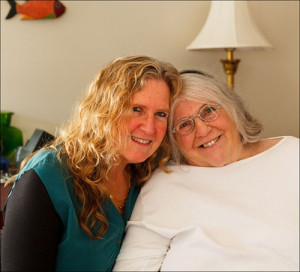
Lise and Sunni Bloland in 2014.
“My biggest influence in college was Sunni,” Lise says. “I took all her dance classes and eventually worked as her TA (teaching assistant) for many years. I learned a lot about teaching from her and how to break down dances so they made sense to people.” Although Sunni Bloland’s specific focus was Romanian dance, she taught dance from many countries; her three levels of classes—beginning, intermediate and advanced—were tremendously popular, drawing up to 150 people.
Lise became one of the organizers for the UC Folk Dancers, helping to run the weekly party. “Then we would all go up the hill to the International House and keep dancing until much later—every single Friday,” she says. Other nights they would go to Aito’s, a Greek restaurant, or one of the international folk dance groups in the area.
In 1976, as part of a bicentennial celebration of 1776 that Sunni produced, Lise became part of a clogging group, made costumes and performed—her first experience with performing folk dance. At about that same time she started going out with a folk dancer who would have a big influence on her life.
Carousel Art
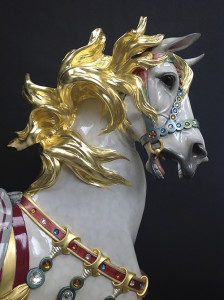 Her boyfriend’s parents did carousel restoration, and Lise started learning about the craft. Not long after, barely making it through college due to dancing six nights per week and having taken most of the art and folk dance classes available at Cal, she dropped out of school and began working an apprenticeship with the parents. Their son later started his own carousel restoration business and, though he and Lise were no longer romantically involved, she worked for him for years, eventually opening her own business in 1987.
Her boyfriend’s parents did carousel restoration, and Lise started learning about the craft. Not long after, barely making it through college due to dancing six nights per week and having taken most of the art and folk dance classes available at Cal, she dropped out of school and began working an apprenticeship with the parents. Their son later started his own carousel restoration business and, though he and Lise were no longer romantically involved, she worked for him for years, eventually opening her own business in 1987.
In the late ‘70s she went back to Cal and designed her own independent major based on the classes she had taken and the work she’d done. She has the only degree ever issued at UC-Berkeley in American Folklore: Carousel Art and History.
Westwind
Shortly after the bicentennial celebration, Lise saw the folk dance group Westwind perform. She thought, “Wow, I want to do that!” and auditioned and got in. One of the directors was Dennis Boxell, an “amazing choreographer and teacher, with impeccable taste. He really knew how to put a performance on that was brilliant,” she says. Although controversy and scandal later eclipsed Boxell’s creative reputation, he had a great, positive influence on her.
In Westwind she quickly rose through the ranks and became choral director of the ensemble’s mixed chorus of about 40 singers, including some extremely gifted singers and instrumentalists. During this era Lise sang with the group Savina as well. She later became dance director and eventually artistic director of Westwind, in a shared position with Joe Finn and Allen Nixon.
Early camps
In 1981, Lise got together with George Chittenden, a winds-playing musician who had recently returned from an extended trip to Turkey, where he had studied zurna. The next year, Lise went with George to her first Balkan camp, at Mendocino.
“I got a scholarship to work in the kitchen,” she says. “In those days it was an eight-hour commitment. Pretty much you did that and got to take one class. We worked so hard in the kitchen, but it was so exciting, and we were in our 20s, so it was no problem to stay up and party all night.”
Camp was different in those days than the family-friendly scene it is now. Lise remembers everyone being more or less the same age at the camps, with “a lot of hanky-panky and hooking up going on.” She remembers taking walks down to the creek (something she rarely does now); in those days it seemed there was more time to enjoy nature, despite the kitchen duties.
“I remember the singing classes,” she said. “It was Carol Silverman,1 Carol Freeman2 and Lauren Brody.3 It was hierarchical—you had to take the beginning class, and then you graduated to the intermediate class. Only if you were good enough did you get to take the advanced class.” (These days, although different levels of singing are still offered, there is no such hierarchy.)
By 1984 Lise was playing percussion, tambura and tamburica music, and singing and dancing. That year at camp she heard a santouri for the first time.
“I heard it and thought, ‘Whoa. What’s that?’ and ran over to the room where it was being played. I couldn’t believe what I heard. It was so lyrical—a light sound, but also strong because it was percussive. It was harplike; not a drum, not a wind instrument. It was so different.” A woman named Lisa Rose was playing.4 The next year, Lise and George went to East Coast camp at Buffalo Gap; Lise ordered her first santouri from longtime EEFC workshop teacher Yianni Roussos5 and started studying the instrument with him.
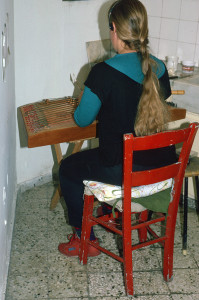
Practicing in Athens in 1986.
Studying santouri and travels abroad
The next year she and George took a year off from work and lived in Athens, Greece, for six months, to study music. But first they traveled from northern Greece to Eastern Turkey with Joe Graziosi6 and David Bilides (both EEFC Workshop instructors)—neither of whom they knew very well at the beginning of the trip. The four ended up having a great time.
“In those days, there were no cell phones or Internet,” she says. “If you wanted to call home, you had to go wait at the post office for two hours. All our mail went to poste restante [general delivery] in whatever city. Such a different time than it is now, when everybody just calls everybody on Skype. There’s no getting away. But we were really away for a year, out of touch.”
In Athens, Lise studied with master santouri player Tásos Dhiakogiórgos, a classically trained musician. This was in contrast to the folk musicians with whom George was studying gajda, zurna and clarinet, whose teaching methods seemed completely random. Lise also had brief studies with two other santouri masters: Yiannis Sousamlis, a.k.a., Kakourgos; and later Marios Papadeas.
Wedding and work life
In 1987, back in Albany, Calif., Lise and George rented the Mendocino Woodlands (the Balkan camp site) for a four-day wedding celebration with dancing to live music played by many friends, including Yianni Roussos, whom they brought in from the East Coast. They showed slides of their travels in Greece, Turkey and Africa.
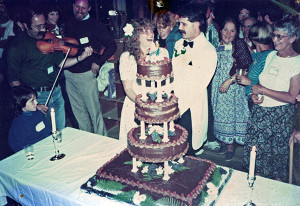
Lise and George's wedding party at Mendocino, 1987.
Lise’s full-time return to her carousel business coincided with a peak in the carousel-collecting world; there were conventions where she would be invited to speak. and she would go speak at them. People were spending tens of thousands of dollars on carousel animals. That’s not the case anymore, she says.
“I hit at just the right time to build a business when interest in carousel collecting was on the rise,” she says. Although there are many carousel restoration specialists in the U.S., Lise is one of only about a half dozen that do high-quality work. “I still have good business, but it’s not like it used to be, where I was backed up for two years and people would get on the waiting list. I feel like I came into this at a very, very serendipitous time.”
Ziyiá and Édessa
Joe Graziosi had been telling Lise, George and drummer Dan Auvil that they needed to meet Christos Govetas7 and Beth Bahia Cohen,8 who were playing Greek music in Boston. At the 1990 Mendocino Balkan camp they all met and formed the bicoastal band Ziyiá, to specialize in regional traditional music of Greece.9
Soon Ziyiá got involved in the Greek Orthodox Folk Dance & Choral Festival known as FDF (for Faith, Dance and Fellowship)—a large festival held annually in Southern California—and started to really build repertoire together. In the early days Bob Beer and David Bilides often performed with them. They started becoming known in the Greek community and were hired for weddings and workshops and camps all over the country.
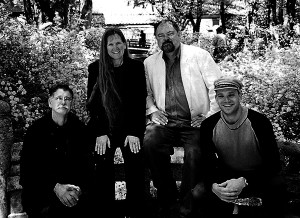
Edessa in Japan.
In the early ’90s, in connection with one of those workshops, they learned some music for Dennis Boxell, who was teaching dances from Édessa (a city in northern Greece, near the Macedonian border). Boxell sent them recordings of some brass band music from the area. The music called for accordion.
George had a student accordion with 12 buttons on the left and two octaves on the keyboard side. Lise learned three tunes on it and they played those tunes at the workshop, with David Bilides on tupan, Dan Auvil on snare and George on clarinet. Little by little, as they got called to play other gigs, Lise would learn a few more tunes on the accordion. (Eventually she got a full-sized accordion.) Later they were joined by Ari Langer on violin and Paul Brown on bass. Numerous other musicians, including several guest singers and various percussionists, have been part of Édessa for shorter or longer periods.
“This was one of the first American bands to play that Florina/pushteno kind of repertoire,” she said. “Look at how many people are playing it now! But this was one of the first live bands that people had heard, and it was so exciting.” Dubbed Édessa Power Block by some of their folk dance fans, the band soon became known as just Édessa.
Lise and George also played in a rebetika ensemble, Rebetiki Paréa, that toured in Holland in 1995. Lise played baglama and santouri, George played guitar, Bob Beer sang, Vaggelis Fragiadakis played bouzouki and Nancy Klein played percussion.
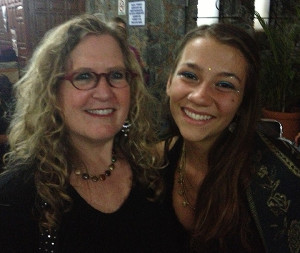
At Mexico camp with Riri Hughes.
With either Ziyiá or Édessa, Lise and George have played and taught at many dance and music workshops, including three in Japan,10 and all but one year of World Camp, an East Coast dance and music camp that celebrated its 20th anniversary this year.
With Souren and Haig
Another important influence has been the music of Souren Baronian and Haig Manoukian, brilliant Armenian American players playing clarinet and oud, respectively, who have been frequent instructors at the EEFC workshops.
Lise, George and Dan met them in the late 1980s at the then-annual Hawaii folk dance camp Makahiki Hou, where Souren and Haig were regulars. Together with percussionist Polly Tapia Ferber the group started playing Turkish/Armenian repertoire and released a recording. After Haig’s death in 2014, the group re-mastered and re-released that recording, “Near East Far West.”
Next generation?
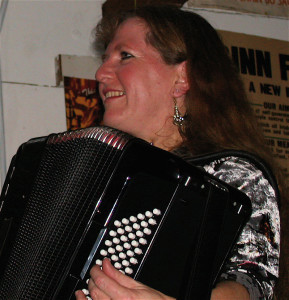
Playing at Ashkenaz with Edessa.
The EEFC’s Program Committee, on which Lise serves, has been talking a lot about the young generation that’s been coming to the camps. Most of them are not coming to it from dancing; in the Bay Area there are clubs where 500 people will come to hear a brass band play. Those people are not so interested in traditional dances that line up with the music, but they do love to dance—freestyle, energetically and preferably to fast music.
“Do we want those 500 people at camp? Maybe; it would be a different camp. And is that what we’re working toward? Is that really the mission? It could be,” she says. “There are not many young dance teachers. Alex Marković is the youngest person we’ve seen. There are some in the Greek community, but they’re not interested in coming into our community, and it’s not for lack of asking. No matter how wonderful our older dance teachers are, if you’re a 20-year-old and you see an old dancer, it just might not be as exciting as seeing a really hot-shit 25-year-old. We need dance teachers like that and we are trying to find them.
“We’ve talked about having some young folks do some very simple dance lessons before some of these hipster gigs in the Bay Area. It wouldn’t have to be a great dancer, or even someone we would hire as a teacher at the camps, but someone young and enthusiastic who could tap into that hipster crowd to get them to actually start to like line dancing. I think that might be the future, to find young people like that who then tap into this younger crowd that’s going out for brass music.”
The EEFC and life
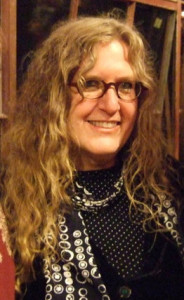
(photo: April Renae)
Lise served on the EEFC Board in 2000 and 2001 and has worked on the Program Committee for many years.
“I enjoy the work,” she says. “It’s like a big puzzle, putting together 25 teachers for an interesting week. You can‘t please everybody; there will always be people that kvetch about something. But more often, people are just thrilled. They can’t wait for camp and then they get there and say, ‘Oh, wow, I can’t believe you got that person.’
“The camps have provided George and me an environment to meet so many amazing people we might not have met otherwise,” she adds. “I think that’s why I want to do the programming work. It’s challenging work and there’s no compensation for it, not even a work exchange; if I want to go to camp and am not on staff, I have to pay to go to camp. But I feel like this is a way of giving back. Balkan camp has given George and me an unbelievably rich life and continues to do so.”
Footnotes
1. Profiled in KT Spring/Summer 2001.
2. Profiled in KT Spring/Summer 2000.
3. Profiled in KT Summer 2006.
4. Years later, Lise bought that very instrument from Lisa Rose, and it’s currently on loan to Nesa Levy, another musician in our community.
5. Yianni Roussos has declined to be profiled in Kef Times.
6. Profiled in KT Spring/Summer 2003.
7. Profiled in KT Spring 2010.
8. Profiled in Spring 2009.
9. See the story of Ziyiá’s first 10 years in the Spring/Summer 2000 Kef Times.
10. Read about Édessa’s teaching in Japan in our Fall/Winter 2001-2002 issue.


